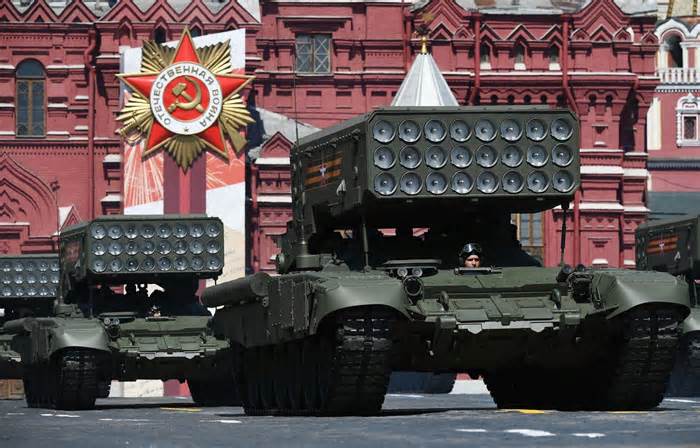
So Far Russia Is Losing The Long-Predicted Space War Against The West
- by Forbes
- Jun 26, 2024
- 0 Comments
- 0 Likes Flag 0 Of 5

Russian rocket launchers roll through Red Square: Moscow's missiles have targeted cities and
... [+] cathedrals, synagogues and space centers across Ukraine during 28 months of war. (Photo by Ramil Sitdikov - Host Photo Agency via Getty Images )
Host Photo Agency via Getty Images
Before Kremlin troops and tanks began crashing across Russia’s borders, before their missiles started setting Ukraine’s cities and cathedrals afire, their leaders launched a clandestine mission they believed would help bring swift victory in a lightning war.
Russia’s notorious military intelligence directorate executed a cyber-ambush that played out almost perfectly: hitting the ground stations of an American satellite network that Ukraine’s president and heads of defense depended on to communicate with each other and command their soldiers.
The stealth attack speedily destroyed tens of thousands of Viasat modems, jeopardizing vital lifelines connecting Kyiv with its defenders across the nation, and with allies around the world.
A European Ariane 5 rocket lifts off with a Boeing-built Viasat satellite. Viasat's terminals were
... [+] ambushed in a stealth attack orchestrated by Russia's notorious military intelligence directorate (Photo credit: JODY AMIET/AFP via Getty Images)
AFP via Getty Images
Isolating Ukraine’s top commanders behind a digital Iron Curtain as Russia’s tanks aimed to capture the capital, with a blare of rockets targeting television and telecommunications towers, was part of a massive mission to smother the embattled democracy’s guardians in “the fog of war,” says Victoria Samson, Chief Director, Space Security and Stability at the Washington-based think tank Secure World Foundation.
Central to that mission was destroying Kyiv’s links to the American constellation that provided the president and his security council with internet coverage, and the ability to coordinate Ukraine’s resistance, Samson, one of the top space defense experts in the U.S., told me in an interview.
The Russian military’s laser focus on quickly crushing Kyiv’s ability to tap leading-edge space technologies, she says, was recently highlighted in a chronicle compiled by her confrères at the Center for Naval Analyses.
These CNA scholars, after scouring treatises and orders issued across the Russian military sphere, reported that “controlling access to space‑based information is seen as conferring enormous advantage in terms of … enhanced warfighting capability.”
Russia’s upper-echelon defense strategists also believe it is imperative to destroy an enemy’s space-related ground infrastructure "during the initial period of war, when both sides are likely to preempt with, in Russian parlance, an ‘information strike’ to disable adversary command, control, communications, computers, intelligence, surveillance, and reconnaissance,” the CNA experts add in their report, “The Role of Space in Russia’s Operations in Ukraine.”
The overarching importance the Kremlin’s generals place on obliterating an adversary’s space technologies at the very start of a conflict explains Russia’s tightly synchronized invasions of Viasat’s network and of Ukraine’s territory - neither of which was heavily guarded.
“Russian forces did deliberately attack the Viasat terminals in an effort to interrupt Ukrainian military communications as they invaded Ukraine,” Samson told me. “Russia has never officially admitted it was behind the attacks but the U.S. and its EU partners formally declared it to be the case in May 2022.” The British Foreign Secretary, after charging “Russian Military Intelligence” with organising the cyber-blitzkrieg, vowed it would face “severe repercussions.”
Back in Moscow, Kremlin celebrations over trapping Kyiv’s leaders inside an information black hole, even as its armoured battle group crept toward the capital, were abruptly abandoned.
Russian soldiers sealing off Red Square in Moscow to stage a celebration of a battle victory in
... [+] Ukraine (Photo by ALEXANDER NEMENOV/AFP via Getty Images)
AFP via Getty Images
In an operation resembling the Berlin Airlift - staged to rescue another democratic enclave surrounded by Kremlin shock troops - SpaceX founder Elon Musk began rushing tens of thousands of Starlink stations into Ukraine, plugging the country back into the World Wide Web via his broadband-beaming satellites circling the globe.
Maxar Technologies and Planet Labs, creators of cutting-edge imaging satellites, began flooding Ukraine’s presidential palace, and the world’s leading newsrooms, with high-resolution panoramic photographs - shot from space - of the Russian line of tanks stalled outside Kyiv, of mass graves that began appearing across Russian-occupied villages, and of the shellshocked cities bombarded by Moscow’s missiles.
As the Russians invaded Ukraine, they attacked prominent houses of worship, like the Church of St.
... [+] Andrew shown in this image captured by Maxar's orbital cameras. Satellite image (c) 2022 Maxar Technologies.
DigitalGlobe/Getty Images
Please first to comment
Related Post
Stay Connected
Tweets by elonmuskTo get the latest tweets please make sure you are logged in on X on this browser.
Sponsored
Popular Post
Tesla: Buy This Dip, Energy Growth And Margin Recovery Are Vastly Underappreciated
28 ViewsJul 29 ,2024






 Energy
Energy



















